Articles
- Page Path
- HOME > J Korean Acad Nurs > Volume 45(3); 2015 > Article
-
Original Article
- Psychometric Properties of the Korean Version of the HIV Self-Management Scale in Patients with HIV
- Gwang Suk Kim, Sang Hui Chu, Yunhee Park, Jun Yong Choi, Jeong In Lee, Chang Gi Park, Linda L. McCreary
-
Journal of Korean Academy of Nursing 2015;45(3):439-448.
DOI: https://doi.org/10.4040/jkan.2015.45.3.439
Published online: June 30, 2015
1Nursing Policy Research Institute, College of Nursing, Yonsei University, Seoul, Korea.
2Department of Nursing, Youngdong University, Youngdong, Korea.
3Department of Internal Medicine, College of Medicine, Yonsei University, Seoul, Korea.
4Division of Nursing, Yonsei University Health System, Seoul, Korea.
5College of Nursing, University of Illinois at Chicago, Chicago, Illinois, U.S.A.
6Health Systems Science·College of Nursing, University of Illinois at Chicago, Chicago, Illinois, U.S.A.
- Address reprint requests to: Park, Yunhee. Department of Nursing, Youngdong University, 310 Taehak-ro, Yeongdong-eup, Yeongdong 370-701, Korea. Tel: +82-43-740-1386, Fax: +82-43-740-1389, yhpark118@gmail.com
© 2015 Korean Society of Nursing Science
This is an Open Access article distributed under the terms of the Creative Commons Attribution NoDerivs License. (http://creativecommons.org/licenses/by-nd/4.0/) If the original work is properly cited and retained without any modification or reproduction, it can be used and re-distributed in any format and medium.
Abstract
-
Purpose
- The purpose of this study was to examine validity and reliability of Webel and colleagues' HIV Self-Management Scale when used with a Korean sample.
-
Methods
- The original 20-item HIV Self-Management Scale was translated into Korean using translation and back-translation. Nine HIV nurse experts tested content validity. Principal component analysis (PCA) and confirmatory factor analysis (CFA) of data from 203 patients was used to test construct validity. Concurrent validity was evaluated using correlation with patients' self-rating as a "smart patient" measured using a visual analogue scale. Internal consistency was tested by Cronbach's alpha coefficients.
-
Results
- All items were rated as having satisfactory content validity. Based on PCA and consideration of conceptual meaning, a three-factor solution was selected, explaining 48.76% of the variance. CFA demonstrated the adequacy of the three-domain structure of the construct HIV self-management: daily self-management health practices, social support and HIV self-management, and chronic nature of HIV self-management. Goodness-of-fit indices showed an acceptable fit overall with the full model (χ2/ df(164)=1.66, RMSEA=0.06, SRMR=0.05, TLI=0.91, and CFI=0.92). The Korean version of the HIV Self-Management Scale (KHSMS) was significantly correlated with patients' self-rated smart patient (r=.41). The subscale Cronbach's alpha coefficients ranged from .78 to .81; alpha for the total scale was .89.
-
Conclusion
- The KHSMS provides a valid and reliable measure of self-management in Korean patients with HIV. Continued psychometric testing is recommended to provide further evidence of validity with this population.
INTRODUCTION
METHODS
1) HIV self-management
2) Perceived smart patient
RESULTS
DISCUSSION
CONCLUSIONS
This study was supported by the Korea Centers for Disease Control and Prevention (KCDC) and Hallym University (7-2012-0333).
- 1. Korea Federation for HIV/AIDS Prevention. HIV/AIDS statistics [Internet]. Seoul, Author. 2013;cited 2013 June 16. Available from: http://www.kaids.or.kr/?c=2/37/41/70
- 2. Centers for Disease Control and Prevention. Monitoring selected national HIV prevention and care objectives by using HIV surveillance data-United States and 6 U.S. dependent areas-2010. HIV Surveillance Supplemental Report. 2011;17(3) [Internet]. Atlanta, GA, Author. 2011;cited 2013 June 16. Available from: http://www.cdc.gov/hiv/library/reports/surveillance/2010/surveillance_Report_vol_17_no_3.html
- 3. Aberg JA. The changing face of HIV care: Common things really are common. Ann Intern Med. 2006;145(6):463–465.ArticlePubMed
- 4. Webel AR, Asher A, Cuca Y, Okonsky JG, Kaihura A, Dawson Rose C, et al. Measuring HIV self-management in women living with HIV/AIDS: A psychometric evaluation study of the HIV Selfmanagement Scale. J Acquir Immune Defic Syndr. 2012;60(3):e72–e81. PubMedPMC
- 5. World Health Organization. Innovative care for chronic conditions: Building blocks for actions: Global report. Noncommunicable diseases and mental health cluster. Geneva, CH: Autor; 2002.
- 6. Siegel K, Lekas HM. AIDS as a chronic illness: Psychosocial implications. AIDS. 2002;16:Suppl 4. S69–S76.ArticlePubMed
- 7. Lorig KR, Holman H. Self-management education: History, definition, outcomes, and mechanisms. Ann Behav Med. 2003;26(1):1–7.ArticlePubMed
- 8. Swendeman D, Ingram BL, Rotheram-Borus MJ. Common elements in self-management of HIV and other chronic illnesses: An integrative framework. AIDS Care. 2009;21(10):1321–1334. ArticlePubMedPMC
- 9. Tinsley HE, Tinsley DJ. Uses of factor analysis in counseling psychology research. J Couns Psychol. 1987;34(4):414–424.Article
- 10. MacCallum RC, Browne MW, Sugawara HM. Power analysis and determination of sample size for covariance structure modeling. Psychol Methods. 1996;1(2):130–149. Article
- 11. Park CS, Yoo YS, Choi DW, Park HJ, Kim JI. Development and evaluation of “hospice smart patient” service program. J Korean Acad Nurs. 2011;41(1):9–17. ArticlePubMed
- 12. Davis LL. Instrument review: Getting the most from a panel of experts. Appl Nurs Res. 1992;5(4):194–197. Article
- 13. Lynn MR. Determination and quantification of content validity. Nurs Res. 1986;35(6):382–385.Article
- 14. Kline RB. Principles and practice of structural equation modeling. 3rd ed. New York, NY: Guilford Press; 2010.
- 15. Hooper D, Coughlan J, Mullen MR. Structural equation modelling: Guidelines for determining model fit. Electron J Bus Res Methods. 2008;6(1):53–60.
- 16. Byrne BM. Structural equation modeling with LISREL, PRELIS, and SIMPLIS: Basic concepts, applications, and programming. Mahwah, NJ: Lawrence Erlbaum Associates; 2014.
- 17. Steiger JH. Understanding the limitations of global fit assessment in structural equation modeling. Pers Individ Dif. 2007;42(5):893–898. Article
- 18. Hu L, Bentler PM. Cutoff criteria for fit indexes in covariance structure analysis: Conventional criteria versus new alternatives. Struct Equ Modeling. 1999;6(1):1–55. Article
- 19. McDonald RP, Ho MH. Principles and practice in reporting structural equation analyses. Psychol Methods. 2002;7(1):64–82.ArticlePubMed
- 20. Han HR, Kim KB, Kang J, Jeong S, Kim EY, Kim MT. Knowledge, beliefs, and behaviors about hypertension control among middle-aged Korean Americans with hypertension. J Community Health. 2007;32(5):324–342. ArticlePubMedPDF
- 21. Shrestha AD, Kosalram K, Gopichandran V. Gender difference in care of type 2 diabetes. JNMA J Nepal Med Assoc. 2013;52(189):245–250.ArticlePubMedPDF
- 22. Kara B. Validity and reliability of the Turkish version of the thirst distress scale in patients on hemodialysis. Asian Nurs Res. 2013;7(4):212–218. Article
- 23. Chou FY. Testing a predictive model of the use of HIV/AIDS symptom self-care strategies. AIDS Patient Care STDS. 2004;18(2):109–117. ArticlePubMed
- 24. Aschner P, Horton E, Leiter LA, Munro N, Skyler JS. Practical steps to improving the management of type 1 diabetes: Recommendations from the global partnership for effective diabetes management. Int J Clin Pract. 2010;64(3):305–315. ArticlePubMed
- 25. Breaux-Shropshire TL, Brown KC, Pryor ER, Maples EH. Relationship of blood pressure self-monitoring, medication adherence, self-efficacy, stage of change, and blood pressure control among municipal workers with hypertension. Workplace Health Saf. 2012;60(7):303–311. ArticlePubMed
- 26. Pai HC, Lee S, Yen WJ, Lee MY. Testing of the factor structure of the sexual health knowledge measure with young adolescent Taiwanese girls. Health Care for Women International. 2013;34(10):878–890. ArticlePubMed
- 27. Willis GB. Cognitive interviewing: A tool for improving questionnaire design. Thousand Oaks, CA: Sage; 2005.
- 28. Gomes B, McCrone P, Hall S, Riley J, Koffman J, Higginson IJ. Cognitive interviewing of bereaved relatives to improve the measurement of health outcomes and care utilisation at the end of life in a mortality followback survey. Support Care Cancer. 2013;21(10):2835–2844. ArticlePubMedPDF
- 29. Kim YM, Bazant E, Storey JD. Smart patient, smart community: Improving client participation in family planning consultations through a community education and mass-media program in Indonesia. Int Q Community Health Educ. 2006;26(3):247–270. ArticlePubMedPDF
- 30. Yohannes AM, Dodd M, Morris J, Webb K. Reliability and validity of a single item measure of quality of life scale for adult patients with cystic fibrosis. Health Qual Life Outcomes. 2011;9:105ArticlePubMedPMC
REFERENCES
Figure & Data
REFERENCES
Citations

- HIV self-management and associated factors among people living with HIV in Hunan, China: a nine-year longitudinal study
Lannan Peng, Yeping Wang, Xi Chen, Zhi Xie, Jie Li, Dan Luo
AIDS Care.2025; 37(2): 253. CrossRef - The Impact of Stigma on Self-Management Behavior Among People with HIV in China: The Role of Social Support and Self-Esteem
Haitao Huang, Liao Zhang, Ling Tu, Xiaona Zhang, Hua Zhong, Qianwen Liu, Ying Liu, Hong Chen
AIDS Patient Care and STDs.2024;[Epub] CrossRef - Self‐Management and Its Associated Factors Among People Living With HIV at University of Gondar Comprehensive Specialized Hospital: A Cross‐Sectional Study
Abdisa Gemedi Jara, Masho Tigabe Tekle, Faisel Dula Sema, Banchamlak Teferi Mekonen, Asrat Elias Ergena, Amensisa Hailu Tesfaye, Saron Naji Gebremariam, Rahel Belete Abebe, Eyayaw Ashete Belachew, Abenezer Melaku Tafese, Eden Abetu Mehari, Ali Imran
BioMed Research International.2024;[Epub] CrossRef - Social support, self-efficacy, self-esteem, and self-management behaviors among people living with HIV/AIDS in China: a structural equation modeling analysis
Haitao Huang, Ling Tu, Xiaona Zhang, Liao Zhang, Jianxiong Zhang, Qin Liu, Qianwen Liu, Ying Liu, Hong Chen
BMC Public Health.2024;[Epub] CrossRef - Multidimensional Frailty, Quality of Life and Self-Management in Aging Hispanics Living With HIV
Evelyn Iriarte, Rosina Cianelli, Joseph P. De Santis, Arsham Alamian, Jose G. Castro, Yui Matsuda, Alejandra-X. Araya
Journal of Applied Gerontology.2024; 43(7): 899. CrossRef - Factor structure of the HIV-SM LMIC self-management questionnaire for people living with HIV in low- and middle-income countries
Tegene Legese Dadi, Girmay Medhin, Mark Spigt
AIDS Research and Therapy.2024;[Epub] CrossRef - Exploring the relationship between illness perception, self‐management and quality of life among HIV‐positive men who have sex with men
Xu Wang, He Xu, Yao Zhang, Jing Zeng, Cong Liu, Rui Luo, Haidan Zhong, Weiping Cai, Linghua Li, Jing Gu
Journal of Advanced Nursing.2024; 80(12): 4963. CrossRef - A Study on AIDS Self-Management Status and Its Influencing Factors
Dong-Xia Wu, Jing-Xian Hu, Jian-Hong Ma, Ke-Yi Chang, Yun Zhang, Xiao-Li Quan, Jia-Ning Han, Hai-Jing Long, Chen Chen, Wei Zhai, Huan-Huan Guo, Li-Li Zhang, Xiao-Lan Wang
Journal of Multidisciplinary Healthcare.2024; Volume 17: 4373. CrossRef - The relationship between HIV-related stigma and HIV self-management among men who have sex with men: The chain mediating role of social support and self-efficacy
Yan Tao, Xueling Xiao, Jun Ma, Honghong Wang
Frontiers in Psychology.2022;[Epub] CrossRef - Psychometric properties of the Turkish version of the Diabetes Family Impact Scale
Ismail Cetintas, Melahat Akgün Kostak
Journal for Specialists in Pediatric Nursing.2021;[Epub] CrossRef - Identification of Self-Management Behavior Clusters Among People Living with HIV in China: A Latent Class Profile Analysis
Hong Zhang, Yao Yin, Huan Wang, Ying Han, Xia Wang, Yi Liu, Hong Chen
Patient Preference and Adherence.2021; Volume 15: 1427. CrossRef - Factors influencing self-management of adults living with HIV on antiretroviral therapy in Northwest Ethiopia: a cross-sectional study
Habtamu Areri, Amy Marshall, Gillian Harvey
BMC Infectious Diseases.2020;[Epub] CrossRef - Testing a Question Prompt Intervention to Improve Communication between Patients with HIV and Healthcare Providers: A Pilot Study
Gwang Suk Kim, Mi-So Shim, Jun Yong Choi, Jeong In Lee, Ji Min Kim
Journal of Community Health Nursing.2020; 37(3): 153. CrossRef - Development of a Question Prompt List for Patients Living With HIV and Assessment of Their Information Needs
Gwang Suk Kim, Jae-Phil Choi, Jeong Min Yi, Mi-So Shim
Journal of the Association of Nurses in AIDS Care.2019; 30(5): 575. CrossRef - Mediators and Moderators of Health-Related Quality of Life in People Living with HIV
Gwang Suk Kim, Suhee Kim, Jun Yong Choi, Jeong In Lee, Chang Gi Park, Linda L. McCreary
Journal of the Association of Nurses in AIDS Care.2018; 29(4): 580. CrossRef - Psychometric Properties of Turkish Version of the Dutch Objective Burden Inventory
Canan Demir Barutcu, Hatice Mert, Murat Bektaş
Asian Nursing Research.2015; 9(3): 207. CrossRef
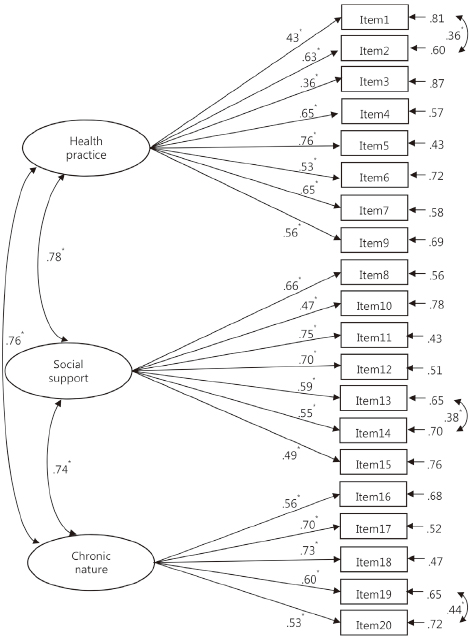
Figure 1
Demographic and Medical Characteristics of the Participants (N=203)
*Total of each variable varies because of the exclusion of nonresponse or missing data.
Baseline Distributions and Item Factor Loading of HIV Self-Management Scale
HIV=Human immunodeficiency virus.
Summary of Model Fit Indices from Confirmatory Factor Analysis
CFI=Comparative fit index; TLI=Tucker-Lewis index; SRMR=Standardized root mean squared residual; MSEA=Root mean squared error of approximation.
Concurrent Validity and Inter-factor Correlation of the Korean Version of HIV Self-management Scale
*p<.001; HIV=Human immunodeficiency virus.
*Total of each variable varies because of the exclusion of nonresponse or missing data.
HIV=Human immunodeficiency virus.
CFI=Comparative fit index; TLI=Tucker-Lewis index; SRMR=Standardized root mean squared residual; MSEA=Root mean squared error of approximation.
*
 KSNS
KSNS
 E-SUBMISSION
E-SUBMISSION

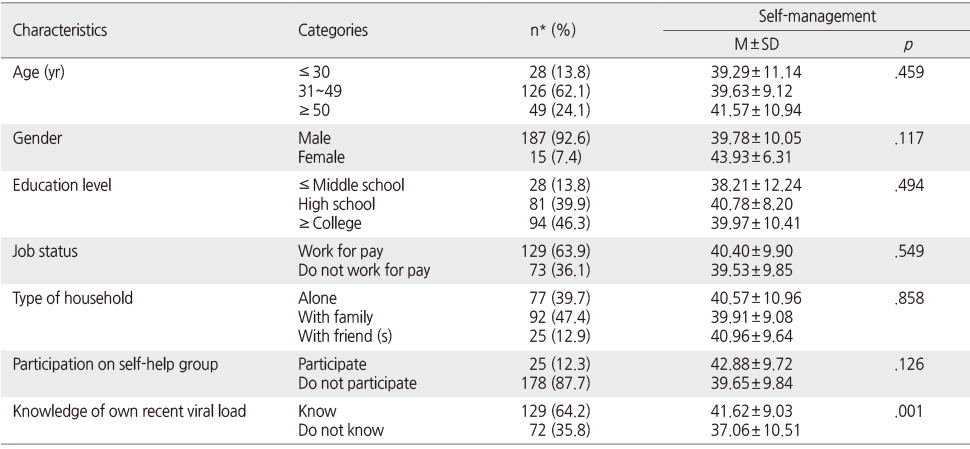
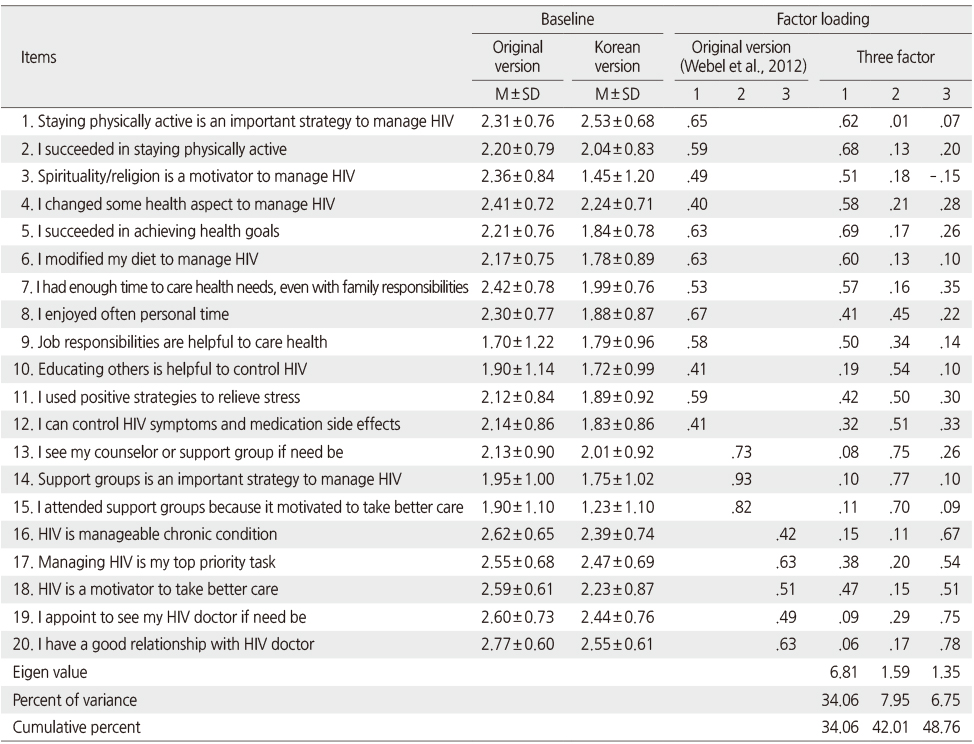
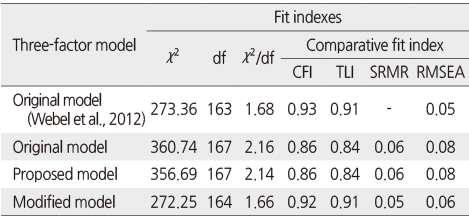
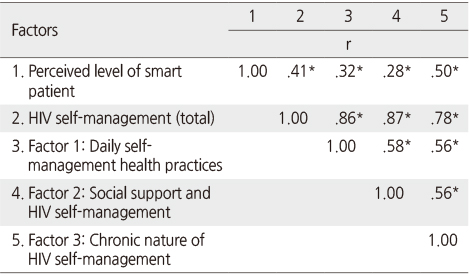
 Cite
Cite

